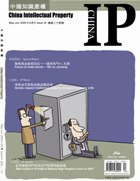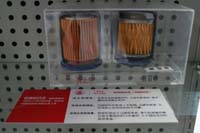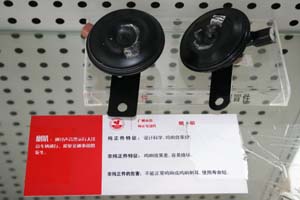
Honda, the Japanese carmaker, is perhaps not comparable to brands like GM or Volkswagen in terms of market share, but it definitely shows signs of dynamic momentum in recent years. Originally a bicycle booster manufacturer in its early years, Honda has evolved into an MNC today, boasting innovative technologies in fields covering motorcycles, automobiles, and general products. With more than 120 manufacturing facilities in 27 countries and regions around the world, Honda rolls out 3.5 million cars annually to consumers.
According to the 2005 Auto Reliability Research published by the British auto magazine What Car?, Honda had the most prominent place among the top ten. Besides Honda being named No.1 reliable brand in the brand reliability poll and its models, Accord and Civic took first and second place on the individual model reliability chart.
Honda entered the Chinese market in 1982 by co-producing motorcycles with China’s Jialing Machinery Factory. In the same year, their Beijing office was established. Currently, Honda has 16 affiliate companies in China, spreading over eleven regional areas including Beijing, Tianjin, Shanghai, Guangzhou, and Hong Kong. Honda has been engaging in IPR protection since its appearance in the Chinese market. According to Mr. Shuji Kato, General Manager of the Legal & Intellectual Property Division, Honda Motor (China) Investment Co., Ltd., “Honda’s presidents all have technical backgrounds. Therefore, they are fully aware that without advanced technology, there will be difficulties for the company’s further development. At the same time, Honda has a zero tolerance policy towards IP infringements. The company, from top to bottom, is highly supportive with regards to IPR protection.”
As of December 2007, Honda’s China portfolio includes over 500 applied or registered trademarks, 3,800 published or granted invention or utility model patents and more than 1,100 granted design patents. On October16, 2006, the trademark HONDA was certified a famous mark in China by the State Administration for Industry and Commerce (SAIC). Thus far, Honda has filed 62 IPR related lawsuits, which is uncommon among foreign enterprises. From 1998 to December 2007, Honda has assisted administrative departments in industry and commerce, quality and technical supervision and customs in 21 provinces, districts, and cities, including Guangdong, Jiangsu, Beijing, and Liaoning, with 2,500 actions against infringements. This clearly shows Honda’s efforts in the area of IPR protection.
Honda upgraded the former intellectual property office into a division in April 2002. The China IPR division was also officially established, and the scope of work was accordingly expanded. Honda Motor (China) Investment Co., Ltd. incorporated the IPR division after the company was established in January 2004. This was the origin of the Legal & Intellectual Property Division. The division includes Mr. Kato and a staff of four. It deals mainly with IPR related issues in China. Due to the lack of personnel, the division’s main task is to provide support on IPR issues according to the patents owned by Honda in China. Although they do not directly report to headquarters, the work of the Legal & Intellectual Property Division has great relevance to the head office Mr. Kato said: “We communicate regularly with the headquarters. Sometimes the headquarters give us directions. Sometimes we will also tell the headquarters what should be done in China, in order to gain support from them and improve our efficiency.”
“Respect intellectual property; bring joy to people’s life” is Honda’s IPR credo in China
“The entire secret of my success lies in: never imitate others, be determined to create high quality products never done before. Only with untiring efforts, did I make it to the top of the auto industry. ” This is the operation principle of Honda’s founder, Soichiro Honda. With a mechanical background, Mr. Honda was aware that machines could operate as long as there were fuel and lubricants. Similarly, a philosophy was needed for the operation of an enterprise. Accordingly, he created the Honda credo with the basic principles, “Respect for the Individual” and “The Three Joys”— “the joy of buying, the joy of selling and the joy of creating.”


Genuien& counterfeit spare parts show in the 4S
According to Mr. Kato, The Three Joys are to a certain extent, related to the IPR work. The joy of buying refers to customer satisfaction in products and services, promote mutual understanding and stir emotions. The purpose of IPR protection is to avoid the purchasing of counterfeits auto parts. The most important is to bring the joy of buying to the consumer. The joy of selling and creating refers to bringing joy to Honda’s dealers and manufacturers by selling and producing Honda’s products. Thus, Honda’s actions against counterfeiting efficiently protect the dealers and manufacturers’ interests, enabling them to experience full joy. This is also an important aspect of Honda business. Based on the company’s philosophy, Honda established their IPR principle and credo in China: respect intellectual property, bring joy to people’s life. “In order to realize this philosophy, we need to crack down on counterfeits of Honda products, providing a clean market for the customers. Simultaneously, Honda spares no effort in protecting our collaborating companies and employees’ legal rights and interests in China.” Mr. Kato explained.
The focus of Honda’s work in China: take full advantage of IPR
IPR is an integral part of a company. Therefore, IP strategy must be in line with the enterprise’s general development strategy and scope of business. Honda’s operating strategy is “where there is a demand, there is production.” Accordingly, the most basic of Honda’s IP strategy is “providing necessary support on IPR related issues to meet the need of development in the local market.” Mr. Kato said, “In order to provide maximum protection of the customers’ interest and for the development of business as well, the major task of Honda’s IP work is to create intellectual properties with high efficiency and secure IPRs, thus taking full advantage of IPR.”
“The Chinese market,” in Mr. Kato’s comment, “has been experiencing dramatic changes. Infringement started in 1996, first on Honda’s trademarks, then on the design patents and utility models. In recent years, infringement sped up and the infringement skills are becoming more crafty and tricky. As a result, Honda is facing growing pressure. For example, a couple of years ago, it might take 2 or 3 years for counterfeit products to appear in the market after Honda’s original’s launch. However, since 2007, as soon as Honda launches a new product elsewhere, some Chinese companies will start counterfeiting. Some counterfeits or fakes appear in the Chinese market even before Honda starts production, which phenomenon exists in fields including trademarks, design and utility model patents. Since it takes some time from the application to the granting of IPR, for those patents still under the application process, if any infringement occurs, Honda cannot exercise their patent rights, which means they cannot protect their business. This is the new situation that Honda is facing in recent years.”
In order to deal with new challenges, Honda focuses on their work in China, taking full advantage of IPR. Mr. Kato said, “Honda has a unique understanding: Some enterprises might choose authorizing other companies for the production of their patent products. This form of licensing is also a way of making full use of IPR. However, in the auto industry, every company has their own independently developed products, and there is no need to purchase Honda’s technology. At the early stage of the company’s development, we also applied for a great number of patents. But they were only kept as assets. IPR is a kind of right. If you obtain the right but do not use it, then its value cannot be realized. It is meaningless for the whole business or the entire society. Therefore, by taking full advantage of IPR we mean, for the development of our business, efficiently utilizing the patent products and fully exercising our rights.”
Currently, Honda is facing a large amount of infringing products, a good number of which are exported, the most typical being bogus auto parts and accessories. “What we must do now is to find out how to deal with these infringements and curb the export of the counterfeits. With this in mind, Honda is carrying out a series of IPR activities, mainly including: a. Infringements track down; b. Intellectual property education; and c. Assisting government’s consumer rights protection campaigns.” Mr. Kato explained.
Tracking down infringements
There are many auto part markets in China. Honda’s research shows that there are more than 10 such markets in Beijing alone, including quite a few unauthorized Honda dealers According to Mr. Kato, “spare parts for the maintenance of Honda vehicles are only sold in authorized Honda dealers. Specifically, almost all dealers with Honda signs in the auto parts markets are operating without authorization from Honda. Additionally, Honda has never been involved in the production of the widely used electric bicycles; yet, many companies are producing them under the Honda name. In fact, Honda has nothing to do with them.
Road safety depends on auto parts of cars and motorcycles. In order to prevent customer loss the Legal & Intellectual Property Division has concentrated their efforts on removing signs and advertisements that infringe on Honda’s auto parts markets nationwide. Concurrently, action has been taken against factories and dealers manufacturing or selling counterfeit Honda spare parts, and against those companies engaged in the fraudulent use of Honda’s name in the electric vehicle business. In 2007, the Honda Legal & Intellectual Property Division assisted administrative departments in industry and commerce, and quality and technical supervision with 600 infringement cases, maximizing protection for manufacturers, dealers and consumers.
Intellectual property education
Honda places great emphasis on intellectual property education for consumers, and implements several campaigns. By way of example, during this year’s “3•15” Honda organized a “counterfeits crack down and consumers’ right protection” exhibition at Guangzhou Tianhe Sports Center, in response to a call from the Guangzhou Administration for Industry and Commerce and the Consumers’ Association. Representatives from Honda explained to consumers, methods by which to distinguish original from fake spare parts, potential damage caused by counterfeit auto parts and provided legal consultation. On April 26, during Intellectual Property Day, Honda participated in the “Brand Auto Original Spare Parts Manufacturers’ Exhibition on IPR Protection and Original & Fake Products Showcase” held at the Beijing Haidian Xijiao Auto Parts City. The staff from Honda surveyed consumers on their awareness of counterfeit spare parts. This information is a valuable resource for Honda.
Apart from the education for consumers, Honda pays great attention in building intellectual property awareness among youths. In March 2004, Honda worked with the Beijing Intellectual Property Office to organize the “First Beijing Youth Invention & Innovation Competition” for primary and middle school students in Beijing. During the same year, the company set up the “Honda Intellectual Property Scholarship” at both Tsinghua University and Peking University in hopes of encouraging outstanding students.
This year, Honda’s intellectual property education will be further strengthened. Mr. Kato said: “During the ‘service week’ held by authorized Honda dealers, we will set up promotional campaigns to explain to the consumers coming into the shops about the danger of using counterfeit spare parts, and encourage them to choose original spare parts.”
Assisting government’s consumer rights protection campaigns
In order to improve quality and technical supervision, administrative departments for industry and commerce, and customs, efficiency in investigating and cracking down on counterfeit products, Honda regularly attends seminars held by the Japan External Trade Organization (JETRO) and Japan Automobile Manufacturers Association (JAMA), such as the SINO-Japan Summit on Strengthening Trademark Protection and SINO-Japan Summit on Exterior Design Protection. Original and phony Honda parts are displayed at these events. Through communication, government offices become aware of Honda’s patents, product features, and positions on infringement, thus improving the efficiency of the relevant departments.
Additionally, the Honda Legal & Intellectual Property Division has been distributing their biannual internal magazine, Intellectual Property Magazine to the various departments since October 2001. The periodical covers fields including Honda’s patents, administrative actions taken in China, methods of distinguishing original from counterfeit products. Mr. Kato said, “Our primary purpose is to make Intellectual Property Magazine a reference for the routine work of the administrative departments and encourage them to track down the counterfeits in the market more actively. In fact, we have seen some improvements. Among the 600 cases investigated and prosecuted by the administrative departments last year, 40% were initiated by the relevant departments.”
IPR protection: still a long way to go
To fight against trademark infringement, the most effective method is to seek help from administrative departments. It is also the most efficient way of protecting consumers’ rights. Consequently, most trademark infringements encountered by Honda have adopted this system However, when dealing with difficult trademark and patent infringements, administrative actions appear to be inadequate. Mr. Kato explained, “Since it is difficult for the administrative law enforcement department to decide whether infringements are conducted against the exterior design patents and utility patents, or whether the similarities exit, we usually turn to prosecution for such cases.”
Honda has amassed a great deal of experience from the 62 lawsuits filed in China. In a typical trademark infringement case, Honda Motor Co., Ltd., Wuyang-Honda Motors (Guangzhou) Co., Ltd., Sundiro Honda Motorcycle Co., Ltd. and Jialing Honda Motors Co., Ltd. against a Chongqing company in December 2004, the Beijing No.2 Intermediate People’s Court stated in the first instance judgment that “there were similarities between “HONGDA” and Honda’s registered trademark “HONDA”. By adopting “HONGDA” signs on the motorcycle products, the alleged infringer conducted infringement against the registered trademark “HONDA”. Accordingly, the court ordered the infringer to pay Honda RMB1.47 million as compensation and to cease production and sales of the infringing products with “HONGDA” signs.
Mr. Kato said, “Many administrative departments had carried out investigations and handed down punishments against the infringements before the case was filed. However, they continued with the production and sales. We also conducted negotiations with them but got no where. The original name of the infringer was ‘XXX HONGDA.’ So it was possible that all their products were marked with “HONGDA” signs. At the time we only filed the case against one particular model. In fact, the compensation of RMB1.47 million is far less than our litigation costs. HONDA is the brand of our enterprise, not just a commodity’s brand. Therefore, we will protect this brand whatever the cost.”
Honda has learned many lessons from the lawsuits. Concerning the compensation calculation, the company adopted the Japanese and American methods. In both countries, if the defendant intends to disprove the compensation amount claimed by the plaintiff, the judge will order the defendant to bear the burden of proof. “However, in this case, we think the defendant did not strictly follow this principle.” Mr. Kato said, “The number of products that the defendant manufactured and the profit margin of each product were all very important statistics. However, these statistics were not made public in China and we had no means of getting hold of them. Since the defendant also did not provide the statistics, we could only calculate the compensation amount on the basis of the public information of emissions in China. This was very inaccurate. In addition, in accordance with Chinese law, there was a preservation of evidence procedure before filing the case, which we applied for, but was dismissed, by the court. In future lawsuits, we will be more cautious and thorough in our case preparations. It also has certain influence on our strategic adjustments.”
Presently, the most important task for Honda in China is to track down counterfeit spare parts. Since Honda dealers maintain records of customers, its current and future tasks will be to distribute brochures, hang posters, display original and fake spare parts to licensed dealers during the annual service week, and to promote and improve intellectual property awareness to their customers.
Mr. Kato completed the interview by eloquently stating that, “China is a huge country. The counterfeits market in China is also hard to predict. The living standard of the Chinese people is rising dramatically. As for the future, there are many uncertain factors for us. However, once a country becomes developed and people’s living standard improves, people will show increasing contempt to the counterfeits, thus leaving less space for the existence of the counterfeits. As for the auto industry, there are many elements closely related to safety, environment protection and people. Therefore, we hope to continue strengthening promotions in this respect and help consumers truly understand and purchase original products.”
(Translated by Elina Cai)
|
Copyright © 2003-2018 China Intellectual Property Magazine,All rights Reserved . www.chinaipmagazine.com 京ICP备09051062号 |
|
|



